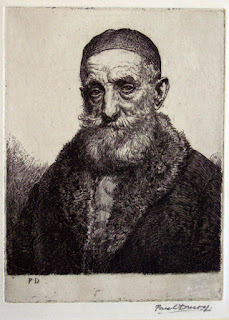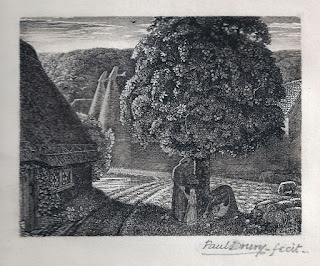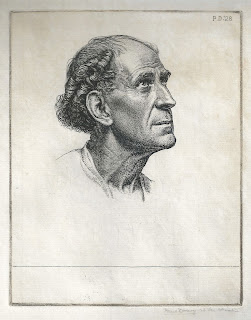Paul Drury (1903-1987) was one of the major printmakers to graduate from
Goldsmiths College in the 1920s. He was part a group of students which included
Graham Sutherland, Edward Bouverie-Hoyton, Alexander Walker and William Larkins
whose work for a time fell under the spell of the Romantic artist, Samuel Palmer.
In Autumn 1824 Larkins came upon a small copy of Palmer’s 1850 etching, The
Herdsman’s Cottage and purchased it. The group became later known as
The
Goldsmiths School or
The New Pastoralists. Palmer was not the only influence on
the group. Initially Durer, Whistler,
Meryon, Millet, Haden and Rembrandt were cited as influences. The group were
also aware of the work of F.L.M Griggs from his images for
Highways and By-ways, rural English travel guides as well as his
etchings which revealed the grand visions of historic English sites. Drury and
Sutherland even visited Grigg’s studio to learn about his printing techniques.
 |
| Head of an old man , etching 1924 |
At that time at the college to almost
completely cover the plate with etched lines, as in the Palmers etching, was almost unheard of. In the
Herdsman’s Cottage, even the lines in the sky are filled with linear marks that run
horizontally across the top right side of the plate. As early as 1924 both Paul
Drury and Graham Sutherland, like Palmer, produced etchings which in most cases
covered the plates with a series of intricate lines which were etched in a
number of successive stages. This enabled rich black areas to be built up through
the overlay of etched lines.
 |
| September, etching 1928 |
In his important book,
Revelation to Revolution; The Legacy
of Samuel Palmer, Jolyon Drury (2006) p.39, notes that after they had been introduced
to the Palmer etching they… “Took trips
down to Shoreham to sketch Palmeresque motifs. They began to understand the
essential quality of light and luxuriant foliage of Kent summer lanes and
hedges.”
 |
| Evening, wood engraving 1924 |
My initial introduction to Drury was through the British
print expert Elizabeth Harvey-Lee’s exhibition of British prints at The Sydney
Antiquarian Print Fair in 1989 where she showed his etching,
Evening (1924). My
first purchase was
Head of an old man in a skull cap (1924) which shows a
strong influence of Rembrandts etchings. More recently, two later but lifetime
printings of early prints,
September
(1928) and
Evening (1924) have come into my possession.
September is a particularly beautiful Drury etching which for me as an Australian, has a very English quality. It is a nostalgic image of rural life set in the crisp autumn light of the English countryside.
 |
| First Italian head 1928 |
Recently I purchased a second state of Drury's etching of
First Italian Head (1928) depicted above. This delicately etched work features the profile of a man with an upward gaze and a peacful demeanour. In the latter states and the editioned state of this etching the original deliniation of the collar is completely absent and the plate has been reduced in size.
Drury, Jolyon (2006)
Revelation to Revolution: The Lecagy of Samuel Palmer, Author publication, Ashford, Kent




No comments:
Post a Comment